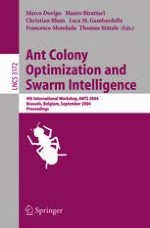2004 | Buch
Ant Colony Optimization and Swarm Intelligence
4th International Workshop, ANTS 2004, Brussels, Belgium, September 5-8, 2004. Proceedings
herausgegeben von: Marco Dorigo, Mauro Birattari, Christian Blum, Luca Maria Gambardella, Francesco Mondada, Thomas Stützle
Verlag: Springer Berlin Heidelberg
Buchreihe : Lecture Notes in Computer Science
Enthalten in: Professional Book Archive
